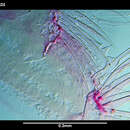en
names in breadcrumbs


"Metavargula, new genus
ETYMOLOGY—Meta from latin meaning "conical or pyramidal figure" in reference to cone-shape medial eye. Gender: feminine.
TYPE-SPECIES—Metavargula ampla, described herein.
This genus has been established to include a new species, M. ampla, and the species M. optilus, which Kornicker (1968) referred to Bathyvargula Poulsen, 1962. In order to include M. optilus in the genus Bathyvargula, Kornicker (1968) amended the original description of Bathyvargula by Poulsen (1962, p. 215). With the discovery of a second species it is expedient to retain Bathyvargula as originally delimited and to establish a new genus to include both species.
Known species of the genus are from deep water. Metavargula optilus was collected at 1000-1200 m in the Gulf of Mexico; M. ampla at 1927-1997 m in the Pacific Ocean.
DIAGNOSIS OF FEMALE (male unknown)—Carapace fairly short, height 54—60 percent of length; carapaces of known two species large, length 3.6-4.65 mm; anterior with broadly rounded rostrum and deep, fairly broad incisur; posterior with elongate caudal process below valve middle; surface smooth, but minute reticulations or pores apparent under high magnification; infold behind rostrum with 20-24 short bristles plus 1 long bristle proximal on list; list anterior to caudal process with 18-29 backward-pointing processes; lamellar prolongation broad along lower margin of incisur, narrow elsewhere.
First antenna: Sensory bristle of 5th joint with 10 long proximal filaments, 2 slender distal filaments and bifurcate tip.
Second antenna: Protopodite with short bare medial bristle. Endopodite 2- or 3-jointed: 1st joint with 3 or 4 bare proximal bristles, 1 long and 2 or 3 short, and 1 long distal bristle; end joint with long terminal sensory bristle; 3rd joint, where present, only slightly wider than base of bristle, but separated from bristle by suture; when 3rd joint present, 2nd joint bare; same specimen may contain endopodites with both 2 and 3 joints. Exopodite: joints 2-9 with basal spines, spines smaller on proximal joints; bristles of joints 3-9 with natatory bristles and without spines; bristle of 2nd joint reaching 7th or 8th joint and with 5-15 spines on ventral margin, 0-14 spines on dorsal margin, and stout spine near tip; 9th joint with 4 bristles, 3 long, 1 short.
Mandible: Terminal spines of coxale endite spinous and separated by small conical process. Medial bristle of terminal ventral pair on 2nd endopodite joint broad and with teeth on inner margin.
Maxilla: Cutting edge of 1st joint of endopodite with 3 teeth; longest a-bristle slender, with pointed tip and long marginal spines; limb similar to that of Bathyvargula.
Fifth limb: Small process between 4th and 5th joints spinous—a similar spined process has been reported on Vargula hilgendorfi (Poulsen, 1962, p. 181) and Cypridina nobilis (Cleve, 1908, pi. IX: fig. 22).
Sixth limb: 2 or 3 small bristles present in place of epipodial appendage; 3rd and 4th endites without medial bristles; end joint broad posteriorly.
Seventh limb: Each limb with 13-24 cleaning bristles; terminus with comb of 8-11 elongate, spinous teeth with digitate tips opposing recurved peg with marginal spines.
Furca: Each lamella with 9 claws separated from lamella by suture; 2nd claw almost same length as first, each remaining claw smaller than previous claw.
Brushlike organ: Consisting of numerous (8-12) minute bristles in vicinity of genitalia.
Upper lip: Anterior part unpaired and with crenulate margin; posterior part with 1 pair of tusks.
Lateral eye: Minute.
Medial eye and rod-shaped organ: Medial eye large, cone-shaped; rod-shaped organ short.
COMPARISONS—Metavargula is closely related to Vargula, Paravargula, and Bathyvargula. Vargula differs from Metavargula in having one or more furcal claws separated from the lamella, well-developed lateral eyes, and a distal bristle on the middle joint of the endopodite of the 2nd antenna. Paravargula differs from Metavargula in having a 1-jointed endopodite on the 2nd antenna, well-developed lateral eyes, and in not having a broad, toothed, medial bristle distally on the ventral margin of the 2nd endpodite joint of the mandible. Bathyvargula differs from Metavargula in having only 1 spine on the bristle of die 2nd exopodite joint of the 2nd antenna, and an endopodite on the 2nd antenna limited to no more than 2 joints. Known species of Bathyvargula have only 8 furcal claws." (Kornicker 1970, p.2-3)